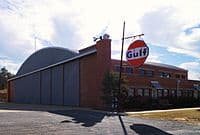There are three American place names that have meaning in the history of the WWII pilots who would become known as the Tuskegee Airmen. First is Tuskegee, second is Tuskegee Institute, and third is Moton Field.
The City
Tuskegee is the name of a small city in Alabama located about 50 miles ENE of Montgomery, the state capital. It was incorporated in 1843. It currently has a population of about 11,500. Rosa Parks, the woman who is largely to considered to have put a face to the beginning of the civil rights movement in the 1960s because she refused to move to the back of a bus, was born there in 1913.
The School
In 1881, a former slave – the son of a black woman and a white man – named Booker T. Washington helped establish the Tuskegee Normal and Industrial Institute which was a school for teachers and those who wanted to learn a trade. Upon graduation, many of the black teachers were hard put to find schools for black children in which to teach because of prevailing conditions in the post-war South.
Washington became a well-known educator and spokesperson for African Americans. He was not afraid to approach wealthy philanthropists like Carnegie and Rockefeller to help finance the building of small community schools for black children where his graduates could teach. He believed that by educating black people to become teachers and skilled workmen who would contribute to society, they eventually be accepted into mainstream America. It was a passive approach with the goal of desegregation.
Famed botanist George Washington Carver taught there for 47 years. His focus was on ways for poor black farmers to use soil that had been depleted by years of planting only cotton. He taught crop rotation that used peanuts and sweet potatoes to bring nitrogen back into the soil which improved the cotton crop. He became famous finding new uses for alternative crops so they would also become cash crops.
Benjamin O. Davis, Jr. who would go on to lead the 332nd Fighter Group of Tuskegee Airmen was teaching military tactics at the Tuskegee Institute when the Army Air Corps opened up flight school applications to blacks. He didn’t have far to go when he was accepted!
The Tuskegee Normal and Industrial Institute later became the Tuskegee Institute. It currently is known as Tuskegee University, a private, historically black school.
The Basic Flight Training School
When the military, under pressure from President Franklin D. Roosevelt, decided to try to train black men to be pilots, the Tuskegee Institute was selected as the site. It provided student housing and food for the cadets and offices for instructors and mechanics. However the main event took place at Moton Field, about 4 miles away.
The airfield was completed in 1942 and named after the late Robert Moton who had succeeded Booker T. Washington as President of the Tuskegee Institute. The air field was the site of primary flight training; after cadets completed that, they moved on to Tuskegee Army Air Field (TAAF) for advanced training. Moton Field is now the site of the Tuskegee Airmen National Historic Site. The picture below is of the Hangar One Museum there.
The CAF Red Tail Project is a volunteer-driven 501c3 non-profit organization that operates under the auspices of the Minnesota Wing of the Commemorative Air Force. For more information, please visit redtail.org.






